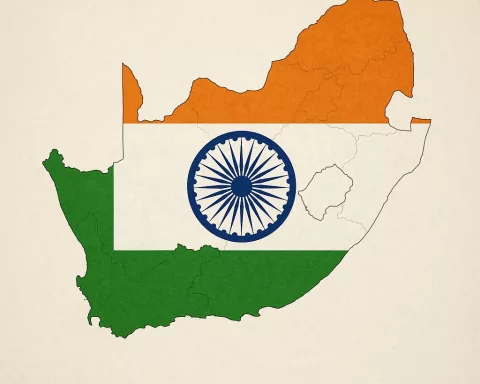South Africa’s government has endorsed a new Financial Inclusion Policy Framework, which seeks to enhance the financial inclusion of individuals and households, widen access to financial services for SMMEs, and utilise a more diversified provider and distribution base for financial services in the country. While more than 81% of South African adults now have access to bank accounts, underlying issues such as economic stagnation and high unemployment still limit comprehensive financial inclusion. The Financial Inclusion Policy aims to tackle these issues, with the National Treasury working with key stakeholders to monitor and track progress towards a more inclusive financial sector.
South Africa’s Leap towards Financial Inclusivity:
The Financial Inclusion Policy Framework by the South African government aims to enhance the financial inclusion of individuals and households, widen access to financial services for SMMEs, and utilize a more diversified provider and distribution base for financial services in the country. The policy lays the groundwork for a more financially inclusive future in South Africa.
A New Dawn in Financial Policy
On August 8, 2023, the South African government made a remarkable leap by endorsing the Financial Inclusion Policy Framework, aptly named, “An Inclusive Financial Sector for All”. This critical shift in financial strategy was initiated by the National Treasury and marks a significant point in the nation’s economic timeline.
This new policy framework is not without foundations. A decade earlier, the National Treasury had issued a policy document, “A safer financial sector to serve South Africa better.” It offered an extensive analysis of the obstacles the financial sector was grappling with and outlined a strategic plan to mitigate these challenges. At the heart of this document was the objective of financial inclusion for all South Africans, an aspiration that has been a constant priority for the National Treasury since it came into being.
Progress and Persisting Issues
Fast-forward ten years, the financial sphere in South Africa shows considerable advancement towards financial inclusivity. More than 81% of the country’s adult populace now has access to bank accounts – an impressive feat that casts a positive light on the national efforts. However, beneath this facade of progress lurk underlying issues. Economic stagnation and the relentless surge in unemployment have left many households with access to only basic financial services, indicating that comprehensive financial inclusion remains distant.
Several challenges underscore the current financial inclusion situation. Traditional formal sector savings remain dismally low, alongside a similarly limited adoption of non-banking products like savings and insurance products, with the exception of funeral, credit, and legal cover products. Despite their prevalence, bank accounts are often underused or misused, while payment options are still in their infancy. Additionally, financial services such as remittances are frequently burdened with high costs, and access to financial services for small, medium, and micro enterprises (SMMEs) remains restricted due to problems of information asymmetry.
Towards a More Inclusive Financial Sector
In response to these challenges, the Financial Inclusion Policy aims to strategically enhance the financial inclusion of individuals and households, widen access to financial services for SMMEs, and utilize a more diversified provider and distribution base for financial services in South Africa. The National Treasury will work hand in hand with key stakeholders, including financial sector regulators, civil society, government departments, the private sector, and other agencies in this endeavor.
As part of its implementation strategy, the National Treasury plans to devise an Action Plan along with a Financial Inclusion Monitoring and Evaluation framework. The objective is to ensure the successful roll-out of financial inclusion strategies and create an active central repository of information to monitor and track the progress of financial inclusion.
The Financial Inclusion Policy and Response Document, offering insights into the National Treasury’s responses to the feedback received from stakeholders, is available to all on the National Treasury’s official website.
The Path Forward
An analysis of the Financial Inclusion Policy reveals that its fundamental objectives coincide with the urgent need for enhanced financial inclusion, extending beyond individuals and households to include SMMEs. The policy emphasizes the requirement for a diversified provider base and an extensive distribution network for financial services.
To sum up, the Financial Inclusion Policy Framework is a major step towards a more inclusive financial sector in South Africa. By pinpointing key challenges and proposing exhaustive solutions, the policy lays the groundwork for a more financially inclusive future. The National Treasury’s dedication to actively monitor and measure the advancement of financial inclusion is laudable and promises to bring about significant changes in the lives of many South Africans.
What is South Africa’s Financial Inclusion Policy Framework?
The Financial Inclusion Policy Framework is a new policy endorsed by the South African government aimed at enhancing financial inclusion for individuals and households, widening access to financial services for SMMEs, and utilizing a more diversified provider and distribution base for financial services in the country.
What are the issues with financial inclusion in South Africa?
Despite more than 81% of South African adults having access to bank accounts, the country still struggles with economic stagnation and high unemployment, limiting comprehensive financial inclusion. Formal sector savings and adoption of non-banking products are low, while payment options and access to financial services for SMMEs are still restricted.
What is the objective of the Financial Inclusion Policy Framework?
The objective of the Financial Inclusion Policy Framework is to strategically enhance the financial inclusion of individuals and households, widen access to financial services for SMMEs, and utilize a more diversified provider and distribution base for financial services in South Africa.
Who are the key stakeholders involved in the financial inclusion endeavor?
The National Treasury will work with financial sector regulators, civil society, government departments, the private sector, and other agencies to enhance financial inclusion in South Africa.
How will the National Treasury measure progress towards financial inclusion?
The National Treasury plans to devise an Action Plan along with a Financial Inclusion Monitoring and Evaluation framework to monitor and track the progress of financial inclusion.
Where can stakeholders access the Financial Inclusion Policy and Response Document?
The Financial Inclusion Policy and Response Document, which offers insights into the National Treasury’s responses to feedback received from stakeholders, is available on the National Treasury’s official website.








